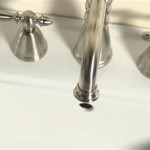What Sealant to Use on a Bathroom Sink Drain
Bathroom sink drains are prone to leaks due to the constant exposure to water. Over time, the sealant used to secure the drain to the sink can deteriorate, leading to water damage. Choosing the right sealant is crucial for a leak-free and durable drain. This article will explore the different types of sealants available and provide guidance on selecting the most suitable option for your bathroom sink drain.
Plumber's Putty
Plumber's putty, also known as "pipe dope," is a traditional sealant used for plumbing applications. It is a pliable, oil-based putty that is easy to apply and forms a watertight seal. Plumber's putty is often used for sealing drain pipes, faucets, and other plumbing fixtures. However, it has some drawbacks. It can be messy to apply, and it may not provide a long-lasting seal, especially in high-moisture environments like bathrooms.
Silicone Sealant
Silicone sealant is a popular choice for sealing bathroom sink drains due to its flexibility, water resistance, and durability. It is available in various colors to match the sink finish. Silicone sealant is easy to apply with a caulking gun and can be smoothed with a damp finger or a putty knife. It forms a strong, flexible bond that can withstand temperature fluctuations and constant exposure to water. However, silicone sealant can be difficult to remove, requiring the use of a sealant remover.
Polyurethane Sealant
Polyurethane sealant is a durable, water-resistant sealant that is often used for sealing exterior projects. It is a strong adhesive that provides a long-lasting seal. Polyurethane sealant can be applied with a caulking gun and cured with a damp cloth. While it is highly effective, it can be difficult to apply and may require special cleaners for removal.
While polyurethane sealant is durable and water-resistant, it is not ideal for bathroom sink drains due to its stiffness. The drain pipe often moves slightly when water flows through it, and the rigid nature of polyurethane sealant can cause it to crack over time. It is better suited for applications where constant movement is not a concern.
Epoxy Sealant
Epoxy sealant is a two-part sealant that requires mixing before application. It forms a strong, permanent bond that is highly resistant to water, chemicals, and temperature changes. Epoxy sealant is typically used for industrial applications, but it can also be effective for sealing bathroom sink drains. It provides a very durable seal, but it is difficult to apply and requires precise mixing.
Epoxy sealant is not recommended for sealing bathroom sink drains due to its high cost and the difficulty of application. Its strength and durability are overkill for a simple bathroom sink drain, and it can be challenging to remove if needed.
Choosing the Right Sealant
When choosing a sealant for your bathroom sink drain, consider these factors:
- Type of Drain: The type of drain, whether it is a standard pop-up drain or a basket strainer, can influence the choice of sealant.
- Material of the Sink: Different sink materials may require specific types of sealant.
- Ease of Application: Some sealants are easier to apply than others.
- Durability: Consider the sealant's resistance to water, temperature changes, and chemicals.
- Removable or Permanent: Determine if you need a removable or permanent sealant.
Silicone sealant is generally the best choice for sealing bathroom sink drains. It offers a good balance of flexibility, water resistance, and ease of application. However, if you need a more durable option, polyurethane sealant can be considered, but it's essential to ensure the drain pipe is securely mounted to minimize movement. If you have a unique drain or sink material, it's always recommended to consult with a plumber for professional advice on the best sealant to use.

Installing A New Bathroom Sink

4 Ways To Seal A Sink Drain Pipe

Should I Use Plumbers Putty Or Silicone For Sink Drain

Plumber S Putty Or Silicone Caulk Which Is Best Tinged Blue

How To Caulk A Bathroom Sink 12 Steps With Pictures Wikihow

How To Re Caulk A Sink

Plumbing Sealant Waterproof Protection For Bathrooms

How To Caulk A Bathroom Sink
How To Re Caulk A Bathroom Sink Ifixit Repair Guide

Bathroom Sink Drain Leaking Around Threads Premier Plumbing Inc
Related Posts







